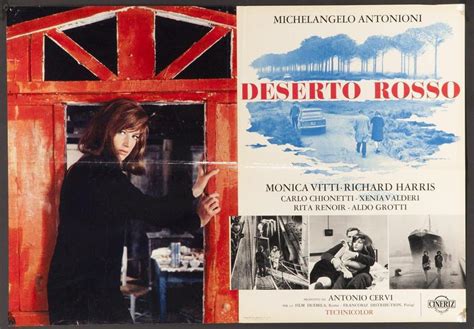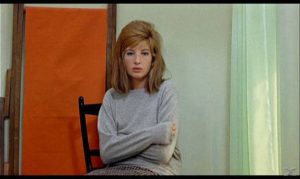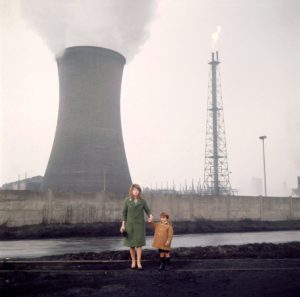
Red Desert (1964)
The Italian filmmaker Michelangelo Antonioni was a survivor of an era, one in which enthusiastic experimentation could still be combined with thoughtful sequences. Antonioni is a fundamental auteur in the evolution of 20th century European cinema, his initial Neorealist techniques were modeled and enriched by the study of different social classes, especially the alienated bourgeoisie. In the early days of his legacy, he was a personal assistant to legendary directors like Roberto Rossellini and Federico Fellini. Soon, he started to shape distinctive styles composed by radical dialogues with aesthetic forms, and his scripts began to take the form of valuable literary pieces.
After cinematographic pieces like L’avventura (1960), La notte (1961), and L’eclisse (1962), Antonioni developed the unparalleled Il deserto rosso (Red Desert, 1964); his tenth feature film and first one in color. These four special titles made up his legendary body of films dedicated to sentimental geography, isolation and the mutations of contemporary man. According to Antonioni: “I want my characters to suggest the background in themselves, even when it is not visible. I want them to be so powerfully realized that we cannot imagine them apart from their physical and social context even when we see them in empty space.”
 Red Desert imposes a unique visual richness for the viewer, the film is filled with a tremendously expressive and allegorical use of color. Antonioni reinvents the language and meaning of colors without limiting himself to photograph the landscapes that nature offers. To quote French painter Henri Matisse: “For the same object there is no fixed color. The blues are not always the sky and the greens are not always trees”. The film moves within the characters but focuses its gaze on the exterior of a modified reality, not only by color, but also by atypical frames and intriguing geometric shapes. The colors are cold and hospitable, they serve to define the emotional changes of the characters. The film’s drama focuses on the mysterious existence of Giuliana (Monica Vitti). Initially, the woman appears with a languid expression and a face of weariness, accompanied by her four-year-old son Valerio (Valerio Bartoleschi). Giuliana is convalescing from a mental crisis produced after suffering a serious traffic accident. Throughout the story, she will be trapped between two men: her husband Ugo (Carlo Chionetti), an industrial electronic engineer, and the seductive outsider/mining engineer Corrado (Richard Harris), with whom the woman believes she can find a way out of her emotional instability.
Red Desert imposes a unique visual richness for the viewer, the film is filled with a tremendously expressive and allegorical use of color. Antonioni reinvents the language and meaning of colors without limiting himself to photograph the landscapes that nature offers. To quote French painter Henri Matisse: “For the same object there is no fixed color. The blues are not always the sky and the greens are not always trees”. The film moves within the characters but focuses its gaze on the exterior of a modified reality, not only by color, but also by atypical frames and intriguing geometric shapes. The colors are cold and hospitable, they serve to define the emotional changes of the characters. The film’s drama focuses on the mysterious existence of Giuliana (Monica Vitti). Initially, the woman appears with a languid expression and a face of weariness, accompanied by her four-year-old son Valerio (Valerio Bartoleschi). Giuliana is convalescing from a mental crisis produced after suffering a serious traffic accident. Throughout the story, she will be trapped between two men: her husband Ugo (Carlo Chionetti), an industrial electronic engineer, and the seductive outsider/mining engineer Corrado (Richard Harris), with whom the woman believes she can find a way out of her emotional instability.
 Removing everything from the plot, which is virtually non-existent, and without distancing itself from moral or political references and views, the film visually builds a stifled suffocating style in which the characters seem to move but remain totally inactive. The events take place inside the outskirts of the Italian port of Ravenna, where Antonioni makes use of an alienating, gray and hyper-industrialized landscape of factories; a sort of desolate concentration camp where consciences are completely destroyed. There’s a huge wave of fog that covers, hides, judges, and defines the characters. The film contains the sense of awareness of the moral dissolution, mental disintegration and decline of an entire social class that thrives on its mentality and misery. In this universe, the everyday world has become a forest of iron: water and land are poisoned, the steel pipes are rusted and threatened. Everything is dead and dehumanized, like all the characters and human relationships. The viewer can breathe the crushing frivolity and lack of empathy in the air. Inside this system, the dissatisfied Giuliana is developing her monotonous life. At one point, she says: “There’s something terrible in reality and I don’t know what it is. No one will tell me”. Giuliana tries to represent intuitive and natural health, but wanders traumatized. The woman wants to react and seek for love or answers, but she only finds sex. Her greatest fear is being afraid, and she cannot find freedom or feel life. Giuliana unravels the simulacrum of bourgeois fiction and contemplates a world in which the decomposition moves between regenerative desire and pain.
Removing everything from the plot, which is virtually non-existent, and without distancing itself from moral or political references and views, the film visually builds a stifled suffocating style in which the characters seem to move but remain totally inactive. The events take place inside the outskirts of the Italian port of Ravenna, where Antonioni makes use of an alienating, gray and hyper-industrialized landscape of factories; a sort of desolate concentration camp where consciences are completely destroyed. There’s a huge wave of fog that covers, hides, judges, and defines the characters. The film contains the sense of awareness of the moral dissolution, mental disintegration and decline of an entire social class that thrives on its mentality and misery. In this universe, the everyday world has become a forest of iron: water and land are poisoned, the steel pipes are rusted and threatened. Everything is dead and dehumanized, like all the characters and human relationships. The viewer can breathe the crushing frivolity and lack of empathy in the air. Inside this system, the dissatisfied Giuliana is developing her monotonous life. At one point, she says: “There’s something terrible in reality and I don’t know what it is. No one will tell me”. Giuliana tries to represent intuitive and natural health, but wanders traumatized. The woman wants to react and seek for love or answers, but she only finds sex. Her greatest fear is being afraid, and she cannot find freedom or feel life. Giuliana unravels the simulacrum of bourgeois fiction and contemplates a world in which the decomposition moves between regenerative desire and pain.
Red Desert arises in a universe of poetic and philosophical thoughts about existential emptiness, inner sadness, denaturalization of the world and the complexity of women’s insertion in modern society. A dream, a patchwork of thoughts and ideas, an abstract visual experience that allows us to carve on it through the years. As the minutes reach the end of the film, this universe paints an extreme canvas that is shaped and transformed into a sublime source of inspiration. The eerie red color works as faded passions: a river of abstract dreamy thoughts and associations of our existence.
by Octavio Carbajal González

Sitting on a beach in Spain and reading your website. A perfect discovery! Greetings, Ivan
Lovely comment, Ivan.
Welcome to the community of Vinyl Writers !.
Thank you Octavio for reviewing my favorite Antonioni film. And what a fantastic review it is! You have perfectly summed up the brilliance of this provocative and at times, apocalyptic movie to a tee. Once again you give me a reason to revisit this magnificent piece of movie making!
Hey Sergio,
It’s always a pleasure to talk about these type of immortal films, but it’s even more special when you develop a profound connection with them. I’ve seen “Red Desert” four times already, never get tired of it.
I truly appreciate your kind words. I’ve revisited and discovered tons of great artists with your IG posts, thanks for being a faithful reader of VW…
Enjoy the film !
Octavio,
This is your most complex, contemplative, philosophical, and reflective film review–you decipher the detailed layers of Red Desert, from its architecture and color symbolism (the Matisse quote succinctly summarizes this) to the decay and degradation environmentally (industrial pollution) and mentally (the main character’s psychological suffocation).
My favorite Antonioni film will always be The Passenger, however, Monica Vitti was his deepest muse and was such a subtle and superb actress in Red Desert and in his “malaise” trilogy. My favorite Monica Vitti performance (my second favorite Antonioni film) is in L’Eclisse (Eclipse) because of her chemistry with co-star Alain Delon.
Mark,
I’m truly honored to hear those words, I know that you’re a passionate follower of cinema.
Henri Matisse’s beautiful “Harmony in Red” was sweeping through my mind when I first watched this film. I think that Giuliana’s character is an absolute mirror of the woman in the painting.
About three years ago, I was digging through the film section of a treasured music/film store, and I found the glorious “Antonioni box”. The images and brief plot of “Red Desert” immediately caught my attention and sparked my curiosity (I was having a hard time).
The “Malaise trilogy” is a beautiful love letter for cinema, what an amazing trio of ambitious productions… I need to revisit “The Passenger”, thank you for reminding me about it.
I fiercely agree with your perceptions about Vitti’s acting in L’Eclisse. The chemistry between Vitti and Delon is something that we rarely see in cinema.
Red Desert, amazing. This movie could also be filmed today in Oberhausen or in the cities beyond, like Liege and Lille. Cities where mining and steel companies were shut down in the seventies and where nothing new was created except for DESERTS.
Ps. I fuckin’ hate your annual summer breaks!
Hey Marius,
I’m not familiar with the events that happened in those cities, thanks for mentioning them…
I’m also sad about the break, but we’ll be back with more music, film and savagery
I hate your summer breaks. See you soon.
See you soon.
Guys, your blog has been so important to me during the pandemic
See you soon, Andy.
It’s great to hear that we enlightened your days in these hard and uncertain times !
The opening sequence of this film alone is devastating. A woman tortured by the emptiness of her existence, at the edge of an inevitable breakdown, the alienation of the modern individual : a red desert is still a desert.
Absolutely agree with you, Viv.
The first scenes left me truly surprised, I was immediately engaged into the whole experience. Beautifully described !
Must watch this. Your last two paragraphs, especially the sentence about the flawed, difficult inclusion of women into modern society and industrialization made me think. Great read.
I’m glad you enjoyed the read, Ulf.
Antonioni was a true visionary, these themes are contemporary catastrophes…
The quality of the articles is impeccable.
Congrats to you and your fellow writers !
Love your writing, I’ll watch this as soon as possible, sounds fantastic!
And good summer break, I’ll miss you!
Thanks, Mark.
We’ll be back with more. Glad you enjoyed the review !
Best screen depression I have ever seen. Wonderful film and review!
Human beings of the 21st century have tried very hard to describe that feeling… perhaps it’s called “depression”.
Thanks for reading, Paula !
Brilliant review. They way you describe the dehumanizing industrial landscapes and their effect on the society and humans centering around them is both hard-hitting and beautiful. Thank you for reminding me of this film, I have to revisit it very soon. Red Desert is a masterpiece by one of the very greats, yet not the first film that comes into mind when talking about Antonioni. In my Damon Albarn article I have dealt with the reasons for why modern music, literature, film… art in general does not thematize climate change, and therefore is detached from reality and has no real substance or relevance. Red Desert, a film almost 60 years old, addresses industrialization as core underlying reason for utter alienation and existential and spiritual emptiness in our societies, but it also addresses the beginnings of the catastrophes to come with the poisoned waters.
Octavio, the last week has been the most life-changing for me, to see parts of Cologne and the surrounding areas drowned in water. People died, people lost everything, but most surreal is also how factories and the industrial landscapes have been drowned and destroyed, big highways have been broken in two, bridges just crushed. These symbols of industrialization and imperialism can just be wiped away within a few minutes, military bases and war machines will drown along with everything beautiful… and maybe somewhere a lonely copy of Red Desert (what a beautiful title) will be floating between the ashes.
Thank you very much for this
-Saliha
Saliha,
A big “thank you” for your positive feedback and great conclusions.
This is a film that exists beyond what we calll “normality”, it transcends unseen realms. It’s like when you enter into a room and forget why you were there… Or those times when you’re standing in a crowd but feel like the only person there.
Red Desert summarizes these peculiar and horrifying emotions. I find a lot of similarities with the films of Hungarian auteur Béla Tarr… the shocking face of humanity against a nondescript background.
I’m very sorry to hear those news about Germany… I’ve been aware of the events, and it looks absolutely horrible. Here in Mexico, we see those floods very often, and it’s simply devastating. As you said, we see the fragility of imperialism against the insane forces of nature.
I loved your last sentences. People often call Antonioni boring. They are wrong….
His works are important because of the emptiness they capture, the void that is slowly approaching to our world.
Hope you are okay, Saliha. Just sent you an email through the contact form.